The GeForce GTX 1060 Founders Edition & ASUS Strix GTX 1060 Review
by Ryan Smith on August 5, 2016 2:00 PM ESTOverclocking
For our final evaluation of our GTX 1060 cards, let’s take a look at overclocking.
We’ll start things off with NVIDIA’s GeForce GTX 1060 Founders Edition. This card has a 3+1 power delivery system and a 116% TDP limit. Like the earlier GTX 1080 and 1070 cards, the GTX 1060FE can be “overvolted” to 1.093v to unlock an additional boost bin.
| GeForce GTX 1060FE Overclocking | ||||
| Stock | Overclocked | |||
| Core Clock | 1506MHz | 1706MHz | ||
| Boost Clock | 1709MHz | 1909MHz | ||
| Max Boost Clock | 1911MHz | 2100MHz | ||
| Memory Clock | 8Gbps | 9Gbps | ||
| Max Voltage | 1.062v | 1.093v | ||
We were able to overclock the GTX 1060FE’s GPU an additional 200MHz (12%), bringing the boost clock to 1909MHz. Unsurprisingly, this is very similar to the GTX 1080 and 1070, both of which overclocked by around 200MHz as well. Consequently it looks like both GP104 and GP106 seem to have similar voltage/frequency curves. Meanwhile we were able to push the memory another 1Gbps (13%) to 9Gbps.
Our other GTX 1060 is ASUS’s ROG Strix GTX 1060 OC. This card features a more advanced cooler and 6+1 power delivery system, but it also ships with a factory overclock. So all things held equal it’s likely that there’s not as much headroom for additional end-user overclocking. Meanwhile the card also ships with a built-in OC setting via ASUS’s GPU Tweak II software, which offers a small, virtually guaranteed overclock.
| ASUS Strix GTX 1060 OC Overclocking | |||||
| Stock | OC Mode | Overclocked | |||
| Core Clock | 1620MHz | 1646MHz | 1720MHz | ||
| Boost Clock | 1848MHz | 1874MHz | 1948MHz | ||
| Max Boost Clock | 2025MHz | 2050MHz | 2113MHz | ||
| Memory Clock | 8.2Gbps | 8.2Gbps | 9.2Gbps | ||
| Max Voltage | 1.062v | 1.062v | 1.093v | ||
As expected, due to its factory overclock the ASUS GTX 1060 doesn’t offer quite as much end-user overclocking. We were able to add another 100MHz (5%) to the GPU, half that of the stock clocked GTX 1060FE. Though it should be noted that in absolute terms the ASUS card has overclocked a bit farther than NVIDIA’s card, with a base clock 14MHz higher and a boost clock 39MHz higher. Meanwhile we got a slightly higher memory overclock out of the card as well, with the card topping out at 9.2Gbps, 1Gbps (12%) over the card’s shipping memory frequency.

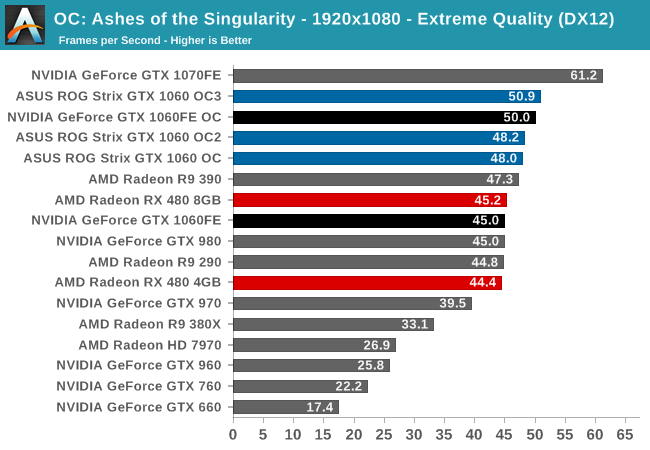
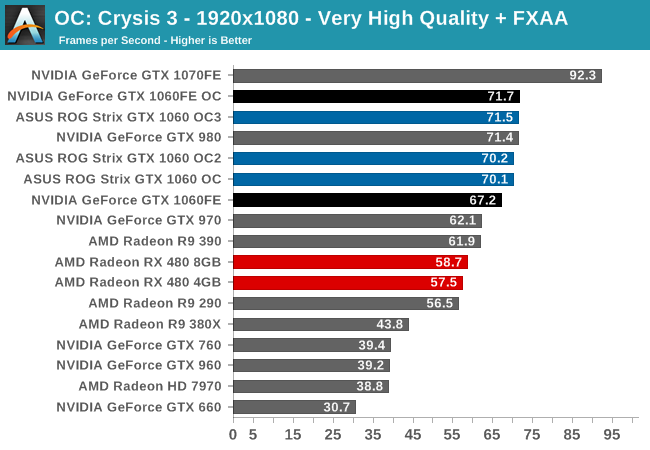

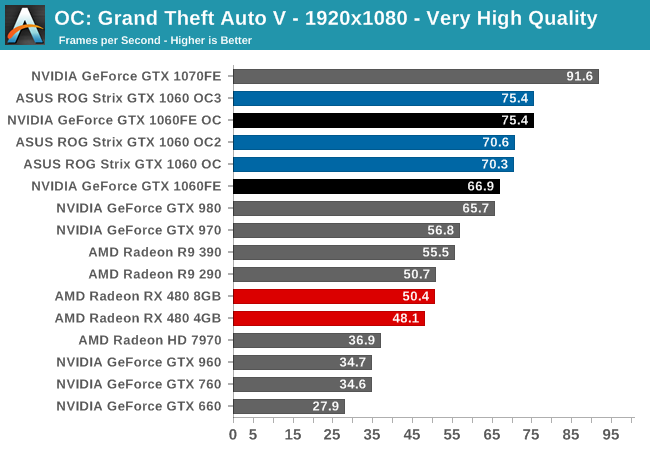
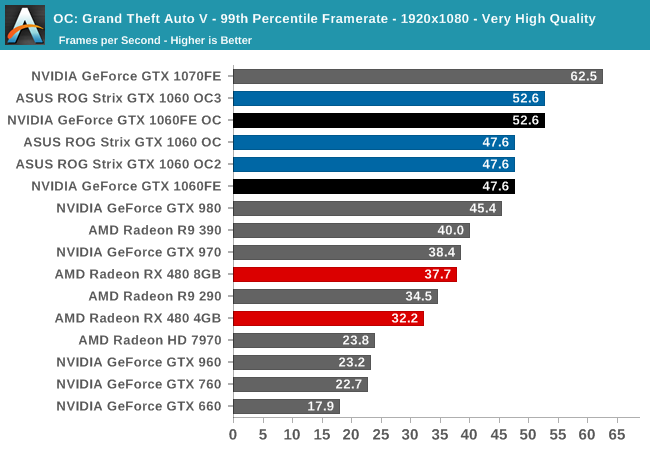
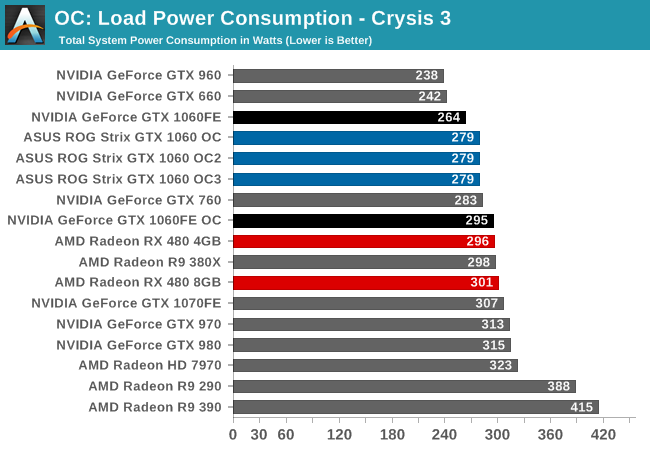
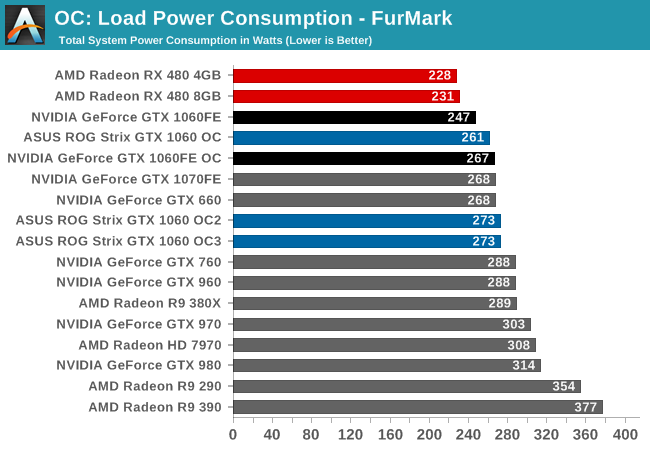
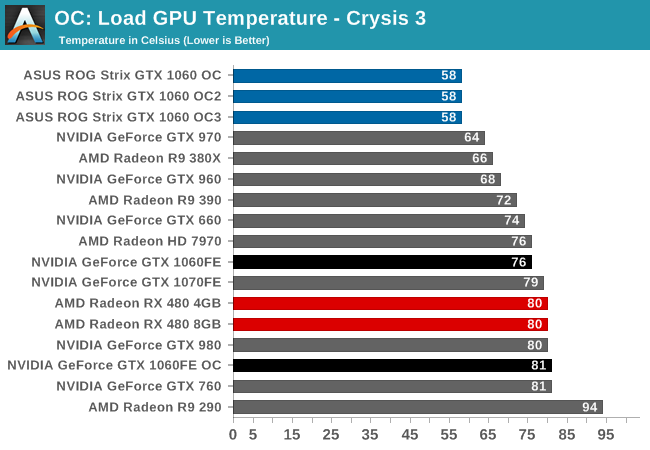
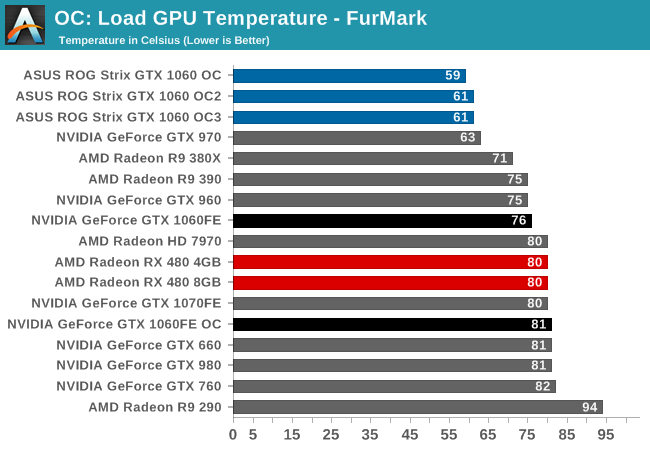
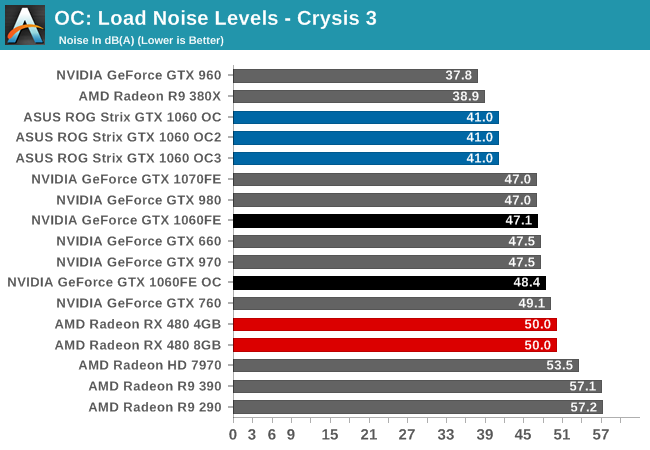
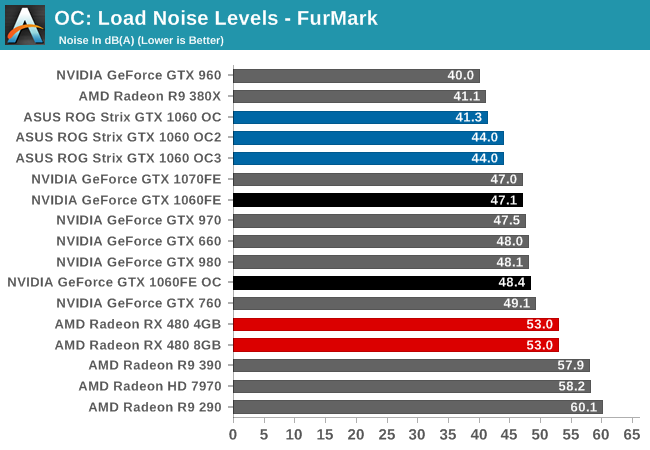
The overall performance gains and resulting power/temperate/noise costs are about as expected. The additional overclock helps the performance of the GTX 1060, but it’s nowhere near enough to close the gap with the GTX 1070. Meanwhile the final overclocks of the NVIDIA and ASUS cards are close enough that their peak performance is neck-and-neck.










189 Comments
View All Comments
Notmyusualid - Sunday, August 7, 2016 - link
Seems amazingly mis-priced.The lowest I see a GTX1060 for, on Amazon.co.uk is 260 GBP (delivered). That is $340 USD.
The pound didn't fall that much.
silverblue - Monday, August 8, 2016 - link
True, but what taxes go on top of that $250? As a Brit myself, that's out of genuine curiosity.thesavvymage - Monday, August 8, 2016 - link
Taxes vary by location, in my state, Washington, sales tax is almost 10% (which i think might be the highest sales tax) so it'd land around 275. UK prices include taxes, US dont, so the price premium isnt as much as you'd initially thinkmdw9604 - Sunday, August 7, 2016 - link
Why aren't the 1080 performance numbers included in the Charts? This thing cost about half as much, would expect about half the performance. But b/c they were not included, can't cant really come to that conclusion.Ryan Smith - Monday, August 8, 2016 - link
While the charts can handle more results, we're trying to keep things readable. If you want a 1080 comparison, Bench would be perfect for this.mdw9604 - Monday, August 8, 2016 - link
Thanks for taking the time to reply, will check it out. Would think it would be useful to include the newest high-end nvida graphics cards for perspective.medi03 - Monday, August 8, 2016 - link
Thanks for the review, Ryan.I've noticed difference in power consumption results between your and other sites (let's take TPU for example).
You are testing total power consumption, which, given PSU's 80%-ish efficiency, should give bigger differences between cards, than if testing power consumption of GPU alone (pcie/connectors).
On your site, ref 480 consumes 37 watt more than 1060.
Ref 1070 consumes 6 watt more than 480.
On TPU site (PCIe, "average gaming"):
1) 480 consumes 47 watt more, which, taking 80% PSU efficiency in account, is 58.7 watt more
2) 1070 consumes a bit less than 480
(review is for an AIB, but I'm comparing Ref vs FE numbers)
https://www.techpowerup.com/reviews/Palit/GeForce_...
Any thought about why that might be? Can chips really vary that much? Is power consumption that different between different games?
Ryan Smith - Monday, August 8, 2016 - link
"Can chips really vary that much?"Yes, especially since these cards are at times TDP limited .Move the temperature up or down by 5F and you'll get slightly different results with blowers, for example. That said...
"Is power consumption that different between different games?"
Absolutely. There can be a massive difference in the CPU load from the simulation, and on the GPU side there's the balance between texturing/shading/ROPing. We can't test all games, so with Crysis 3 we try to pick a game that offers a reasonable middle case. But if someone else uses a different game they can get very different results.
Greeba77 - Monday, August 8, 2016 - link
Great review as always, however I was hoping this would also take in the recent benchmarks that have come out comparing the 1060 to the RX480 using Vulkan on Doom, in which I gather the Nvida card completely tanked. And of course whether this should have any bearing on any decision to buy anyway... if the regular performance is as clear cut as it looks then it seems the 1060 is a pretty good mid range upgrade choice for me (I have an R9 270X at the moment so it's a few generations old and this or an RX480 will smash it.)beck2050 - Monday, August 8, 2016 - link
Great card for the money when prices settle down. Early adopters always pay more for popular tech.